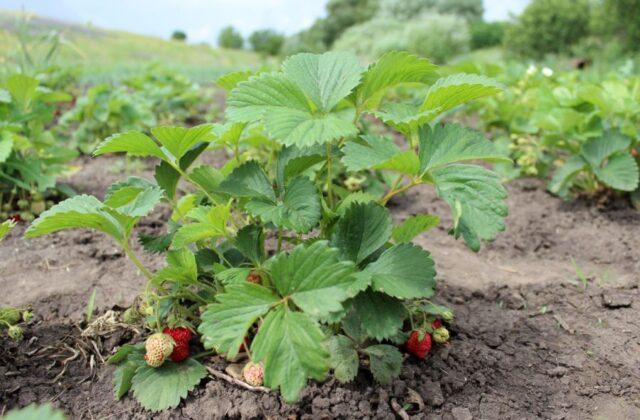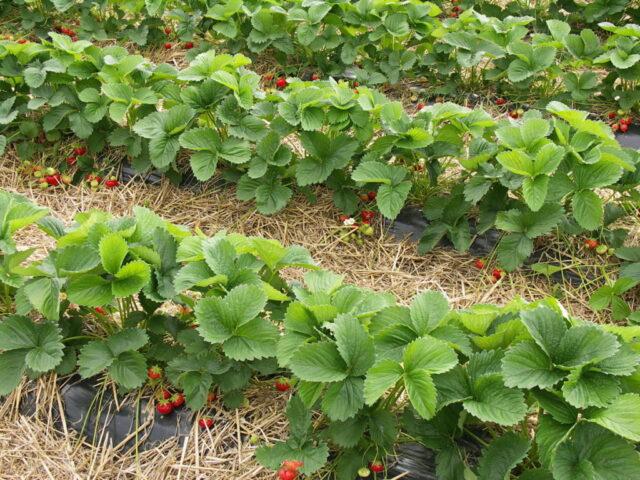Content
- 1 Is it possible and why to replant strawberries in the spring?
- 2 When are strawberries transplanted in the spring, in what month?
- 3 Methods for transplanting strawberries
- 4 How to properly transplant strawberries to a new location in spring
- 5 How to care for strawberries after transplanting in the spring
- 6 Conclusion
Transplanting strawberries in the spring to a new place is an important agrotechnical point that allows you to consistently obtain large yields. The procedure is quite simple, but requires compliance with basic rules.
Is it possible and why to replant strawberries in the spring?
When grown in the garden, strawberries need to be transplanted to a new location from time to time. Usually the procedure is carried out every 3-4 years. There are several reasons that make transplantation an urgent need:
- Soil depletion. If strawberries grow in one place for a long time, over time they begin to lack microelements in the soil, even with regular feeding.
- The appearance of a mustache. The plant produces buds, from which long shoots appear and rise higher along the stem every year. The mustache takes away the strength and resources of the main bush, and in winter they freeze out and provoke rapid aging of the crop.
- Fungi and pests.Regular replanting helps protect strawberries from diseases and parasites that breed in the soil.
In some cases, the reason for the transfer is an unsuccessfully chosen place for the initial placement of the crop. If excess water constantly accumulates in the garden bed, it is better not to wait for the bushes to rot, but to urgently transplant them to another area of the garden.

If you do not replant strawberries, they will quickly shred and begin to bear fruit worse.
pros
You can transfer the crop to another corner of the garden after the end of the growing season. But it is better to replant strawberries in the spring - there are several reasons for this:
- After the snow melts, the soil does not yet have time to be overgrown with grass, so the selected area does not need to be carefully weeded.
- There is a lot of free space in the garden, and you can choose the most convenient and advantageous place to transplant strawberries.
- The ground is well moistened with melt water remaining after the snow melts and does not require additional abundant moisture.
- Most garden crops take root best in the soil in the spring. Strawberries are no exception.
One of the main advantages is that a crop planted at the beginning of the growing season is guaranteed to take root and become stronger by the onset of winter. When transplanting in autumn, survival rate is often in question if frosts arrive earlier than expected.
Minuses
Transplanting in the spring has not only advantages, but also some disadvantages:
- Strawberries moved to a new place at the beginning of the growing season will not produce a large harvest this season. You will have to wait more than a year for large ripe berries.
- When transplanted early, bushes may freeze during return frosts, which often come contrary to forecasts.
- If the weather is hot and dry in the spring, the strawberries will take root more slowly and there is a chance that they will dry out.
The disadvantages include the fact that at the beginning of the season the selection of berry seedlings in gardening stores is much more modest than in the fall. At the same time, plants are much more expensive.

In hot and sunny weather in spring, it is recommended to shade strawberries during the first time after planting.
When are strawberries transplanted in the spring, in what month?
You can transplant strawberries to another place in the spring from the end of March to the end of May. At the same time, different types of seedlings have their own optimal timing:
- Early spring. You can transfer strawberries to the ground immediately after the snow melts. However, during this period, plants are transplanted mainly into closed greenhouses. In the southern regions, the crop is allowed to be rooted directly in a thawed garden when constructing a film shelter.
- From the end of April to the second ten days of May. In mid-spring, strawberry tendrils that have strengthened in the fall are transferred to open ground, and division is also carried out for adult and healthy plants. It is recommended to first wait until the crop begins to grow slightly, and transplant immediately after that.
- At the end of May. After warm weather has finally established itself in the spring, strawberries obtained from seeds are transferred to the ground - they are especially vulnerable in open soil conditions. In the last days of May, you can plant bushes grown in a greenhouse in the garden. They also react sensitively to changes in external conditions.
When transplanted late in May, strawberries often have time to produce buds. During the procedure, the flower stalks are usually removed so that the plant can direct all its forces to rooting.
Methods for transplanting strawberries
Since strawberries actively grow in the garden beds, it is not customary to move them unchanged to a new place. When moving, bushes are divided or tendrils are cut off to increase yield and increase the population.
Transplanting strawberries with rooted tendrils
When replanting in the spring, the easiest way to reproduce is with the help of a mustache. You need to choose the strongest and healthiest strawberry bushes with productive shoots. Usually, several plants are left in the garden in advance for later propagation and their flower stalks are cut off, deliberately preventing fruiting.
The transplant algorithm looks like this:
- On the developed strong tendrils of a strawberry bush, select the first rosettes and place glasses filled with humus in the soil underneath them.
- The shoots are installed in the middle of the containers and secured on both sides with a wire loop.
- Parts of the mustache that are not connected to the main bush are immediately cut off.
- Glasses with buried shoots are watered daily to maintain high humidity, in dry weather - twice a day.
- After the young roots of the rosettes fill the glasses and several leaves appear, the mustache is separated from the main bush.
- The resulting seedlings are removed from the soil and transferred to a new place, if necessary cutting off the shoots that they themselves have produced.
When transplanted using tendrils in the spring, strawberries demonstrate complete survival and die only in rare cases.

It is recommended to take no more than four shoots from one strawberry bush; the remaining shoots must be removed
Transplanting strawberries by dividing the bush in spring
Another method suggests transferring a culture to a new place using division. The transplant procedure is quite simple:
- Healthy and well-developed strawberries are carefully removed from the soil along with a lump of earth and placed in a large pot.
- Old dry leaves and shoots of the plant are cut off.
- The roots are carefully cleared of soil, trying not to leave damage, and the strawberries are lowered into a basin filled with water.
- Wait until the bush separates on its own when it gets wet; if necessary, cut off the horns with a sharp knife.
- On each of the seedlings, three large leaves are left on two stems, and the remaining plates are removed along with peduncles and darkened old roots.
- Treat the feeding shoots in a disinfectant solution and Kornevin.
You can transplant strawberries in May first into pots and grow them a little before transferring them to the ground. But if the weather in the spring is good and the soil on the site is nutritious, then you can immediately place the young seedlings in open soil.

With proper division, strawberries will bring a bountiful harvest this season.
How to properly transplant strawberries to a new location in spring
When transplanting strawberry bushes in the spring, you must follow simple rules of agricultural technology. The culture requires attention from the gardener, but in good conditions it takes root easily.
Selection and preparation of a site
The berry crop prefers moist soil, but does not tolerate stagnant water. When transplanting, strawberries should be placed in an area with a slight slope, located away from underground sources. A warm and sunny place on the southwest side of the garden with shelter from strong winds is best suited for the plant.
When preparing the soil for replanting in the spring, it is necessary, first of all, to dig up the area and remove any remaining plant debris from it. The soil is spilled with a disinfectant solution, after a couple of days 20 g of potassium sulfate, 50 g of superphosphate and 6 kg of humus per 1 m are added to the soil2. After this, the area is dug up again to evenly distribute the fertilizer.

It is not recommended to plant strawberry crops in the garden after potatoes, tomatoes and cucumbers
Selection of planting material
Before transplanting in the spring, the bushes are carefully inspected. Strong, healthy plants are suitable for transfer. If there are no leaves on the bushes even at the end of April and May, or the blades are weak and dull, it is better to place the strawberries in their old place or completely remove them from the site.
Plants with spots and holes on the green parts, limp stems and other signs of disease should not be replanted. Not only will they not take root in the new area, but they are also highly likely to damage neighboring bushes.
Step-by-step instruction
The algorithm for transplanting strawberries to a new place in the spring is very simple:
- In the prepared area, shallow but wide holes are dug. They should be twice as large as the root system of the seedlings.
- The recesses are shed with settled warm water.
- The seedlings are placed in holes and buried level with the ground.
If desired, the strawberry beds can be covered in advance with black film or agrofibre. It is necessary to make slits in the holes and plant bushes directly through them. The covering material will insulate the root system of plants and prevent rapid evaporation of moisture.

When planted in a covered bed, strawberries produce larger and juicier berries, which also do not get dirty in the ground
How to care for strawberries after transplanting in the spring
Strawberry beds require attention from the gardener, but the rules of care are quite simple. There are a few things to keep an eye on:
- Watering. The soil at the strawberry roots should not dry out. In the first month after transplantation and in the absence of covering material, the soil is moistened daily.
- Shading. If the beginning of the season was sunny and with little rain, it is worth installing a small canopy over the beds for at least 2-3 weeks.
There is no need to feed berry bushes in the first year after replanting strawberries in the spring. Feeding is applied only for the second season. During the summer, it is necessary to remove the growing mustache in a timely manner, and with the onset of autumn, the beds should be properly covered for the winter.
Conclusion
Transplanting strawberries to a new place in the spring is a mandatory procedure that must be carried out at least once every 3-4 years. When grown in the same bed, the bushes quickly weaken, and their productivity decreases sharply.








